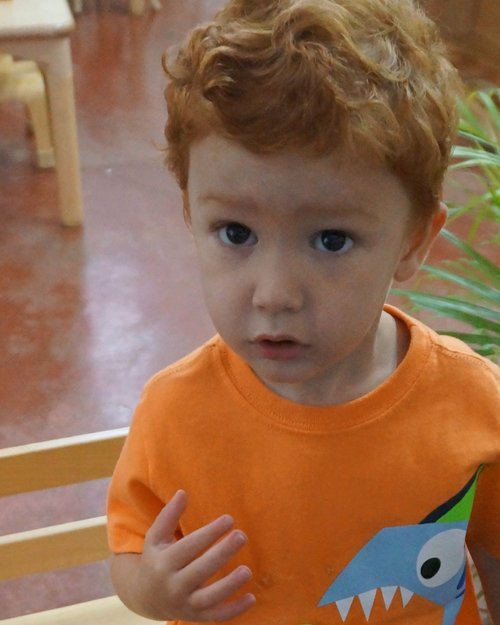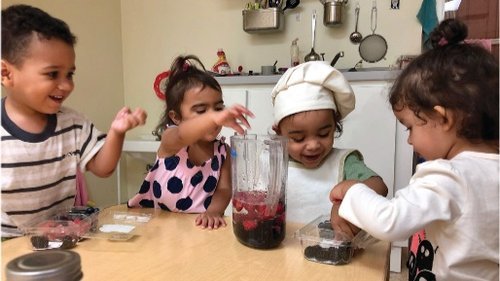Who are the toddlers?
By: Rosana Colón
Who are toddlers?
Toddlers are children that have learned how to walk. They start to carry things with their hands as they toddle and they begin to apply what Montessori called “maximum effort:” they need to practice new movements and work carrying heavy objects. Toddlers also observe with curiosity everything around them: movement, language, the use of things. They possess what Montessori called an “unconscious absorbent mind:” a type of mind that is capable of absorbing absolutely everything around them, without effort or fatigue. They don’t use reason. A toddler doesn’t say to herself: “OK, I think today I’ll absorb the way my dad speaks to me.” No, her own “internal guide” leads her to observe and internalize the way she is spoken to, the activities others do around her, and endless elements of her world. She also repeats with utmost interest the activities she can: she uses her hands, her ways of communicating and her ways of working. We see toddlers go up and down the stairs countless times, look for and read the same books over and over again, sing the same songs, and try the same activities they tried ten times yesterday. Errors are common in this stage (and in all stages of our development), because “to err is to be human.” Mistakes are overcome by trying again and repeating. Repetition, Montessori also reminds us, is a human tendency that helps us concentrate and try again, in our search for perfection (not perfectionism). Ultimately, errors are chances to begin again. We can conclude that toddlers are 1-to-3-year-olds that:
Walk.
Absorb everything.
Explore ceaselessly.
Are interested in cause and effect.
Thrive with order: they need order in the physical and the emotional environment (including adult consistency and a daily routine).
Go through sensitive periods for language, movement, order and the refinement of the senses. They are very sensible to these aspects of development.
Need to repeat activities we make available to them, in order to be able to do them independently.
Communicate in various ways, until, approximately at 2-years-old, achieve an “explosion of language” and the baby that only communicated by crying, gesturing or by saying single words, begins to speak to us nonstop, marveled at his own human discovery.
Are in the process of a very concrete self-discovery. They begin to know and understand their bodies, their language, their potential, and their emotions.
How can we best support toddlers’ development?
Adults would want to respond to these children in the best way possible, understanding how important this stage of life is. We don’t want to become obstacles. Montessori says: “every unnecessary help is an obstacle to the child’s development.” So then, how can we respond wisely to difficult behaviors? How can we know if our help is needed or not needed? A great mantra to repeat to ourselves is: observe, think, and then act. Today, we want to share strategies for observing toddlers’ actions and practicing respectful redirection, considering appropriate limits so that toddlers can develop freely.
Positive redirection
Positively redirecting children means guiding them toward acceptable ways to act and work. We use the word “positive” because instead of over-using the word “no,” we use positive language: we guide the toddler toward what he can do.
First, what should we consider unacceptable behaviors? Any that represent harm to the environment (destroying, painting on walls, cutting things other than paper), to another person (kick, hurt), or to oneself (hurting oneself). How to redirect? Instead of distracting the toddler with a toy or asking him to look another way so that we can take away what he had in his hands, or instead of simply saying “no,” without explaining… we guide him toward what he can do.
Generally, and if the situation is not an emergency, we can use positive redirection. If a toddler is climbing somewhere unsafe, observe this need for climbing and think about a creative solution so that she can safely climb. Maybe she can climb on top of a milk crate or on top of a log outside. Aside from helping us to better connect and tend to the the needs of our children, this strategy can help us think creatively and look for solutions.
Consider development
Another important element is to be understanding in terms of toddlers’ development, establishing age-appropriate expectations. We don’t want to punish a child for doing something that he is designed to do. He is good inside, he doesn’t engage in behaviors because he is “bad” or “nasty,” but rather because he acts according to his laws of development and ceaselessly works towards developing himself. Something we can do is adjust our own expectations, change our own glasses. We can then see that the child that is pushing and pushing the shelf or the table is really expressing a need for “maximum effort,” instead of him “being bad.” Understanding the need, we can redirect him: “I see you’re pushing the shelf. If the shelf falls, it can break. You can push this cart instead.”
Mindful language
We can remember helpful considerations regarding language: speaking directly to the child and communicating in a neutral way, without anger or frustration. Generally, we can give a 1-year-old one direction at a time. For example: “go find your pants.” After saying this, wait. Let the child listen, process and be able to execute. As adults, we can for the most part, immediately control our actions, but 1-year-olds are still developing their language reception and their motor control: in the time that the message travels from the brain to the hand, we have to practice a bit of patience and empathy. Sometime later, maybe after they are 2-years-old, we’ll be able to give twofold directions: “go find your pants and sit on the chair,” so that he can put it on after he sits.
Another consideration is to minimize the use of the word “no.” One of the key reasons is that we want to reserve the word “no” for emergency and safety situations. If we use it all the time, it can lose its effect (like “the boy who cried wolf!”). If the child is just about to touch something that can burn him, or just about to cross the street without my hand, we need to be able to firmly say “no!” and be listened to.
A summary on positive redirection:
Walk directly toward the child and lower down to her level.
Use a neutral, firm, and calm voice. If possible, no anger in your body language or tone.
Use appropriate language for her level of development, so that she can clearly understand. Think about clear and precise language.
Validate her emotions.
Establish an appropriate limit (remember: respecting the environment, others and oneself).
Be consistent and persistent. If you establish a new boundary, be consistent, with calm and confidence in yourself.
Something we haven’t said: practice a lot of empathy and don’t take it personally. This has to do with walking with them in their development, not with our own capability or worth as a caretaker, guide or parent.
Tantrums
Many times, after establishing a limit or redirecting, there can be a strong reaction from the child. First, remember tantrums are normal. They can happen because toddlers don’t have the words that they need to express their emotions in another way, because they are experiencing sadness or frustration of not having things go their way, or because of tiredness, hunger or irritation. Also, remember that they thrive on order? Sometimes, when things lose order in their lives (something changed in the routine, there was a fight amongst adults, etc.), this can destabilize the child. Some elements to remember are:
Validate their emotions:
Safety: If she is throwing things or hurting herself, the recommendation is to intervene calmly and confidently: “I’ll move your body to your room so that you can throw the pillows. I’ll be right here for when you’re ready.”
Give them space: “Here, you can cry all that you need to.”
Process it after it happens: After the tantrum, we can talk about what they can do next time. I don’t want her to conclude that throwing herself on the floor is the way in which I’ll buy her candy, or the way she’ll be able to take something abruptly away from her sister. “This morning, I saw you cried a lot after you couldn’t use your sister’s work. Next time, you can use these words: “I want a turn” and then wait until she finishes
Anticipate: Another powerful tool is anticipation. If there is a tantrum every time screen time is over at night, anticipate: “in 10 minutes, we’ll turn off the screen.” And after the 10 minutes are over and we turn them off, the tantrum can still come, but they will decrease over time.
The Toddler’s Will
Toddlers are also experiencing the emergence of their will. They go through what Silvana Quattrocchi Montanaro called “the crisis of self-affirmation,” in which it is common for them to oppose the adult and say “no.” If I were you, I’d celebrate the fact that my daughter has will. It’s something life gives us and makes us human: wanting to act, work to achieve our wishes. At this time, it’s important to work with my daughter’s will and not against it.
“In truth, what the child does not accept any longer [saying “no”], is our way of speaking to him, in which we continually emphasize that he is small and that he should do as he’s told. At this stage, his ego wants to be considered and consulted when something that involves him must be decided.” (Montanaro, p. 218).
A good strategy is to offer two choices. Instead of asking: “do you want to wash your hands?” To which it is easy to respond: “no…” you may ask: “are you washing your hands with the liquid soap or with the bar of soap?” “¿do you want bread or oatmeal for breakfast?”, or offering two choices of shirts, pants and shoes for the day.
“During this period, what really matters is helping the child confirm the importance of his presence in the family. When he feels sure about this, he will stop saying “no” and continue working peacefully with us. True collaboration only comes from those who do not feel oppressed and can contribute freely. Only when we are free can it be possible for us to choose.” (Montanaro, p. 219)
Once more, these strategies can help us not only connect with the children in our care in a deeper way, accepting who they are and where they are in their development, but they can help us grow in our own life process. We can observe what toddlers are capable of, the things they can begin to choose and the ways in which they develop freely, within the limits we maintain, which are necessary ways of loving them and walking with them during their development.
References:
Bidell, Nikki; Flood, Lisa. “Redrection with Infants and Toddlers”. AMS Event, March 19, 2022.
Dubovoy, Silvia. “Las tendencias humanas”. June, 2016.
Lansbury, Janet. “How to Make No Mean No”. Recovered from: https://www.janetlansbury.com/2020/07/how-to-make-no-mean-no/. March, 2022.
Montessori, Maria. La mente absorbente del niño. Montessori Pierson Publishing Company, 2017.
Quattrocchi Montanaro, Silvana. Un ser humano: La importancia de los primeros tres años de vida. Editorial Cuatro Vientos, 1989.





